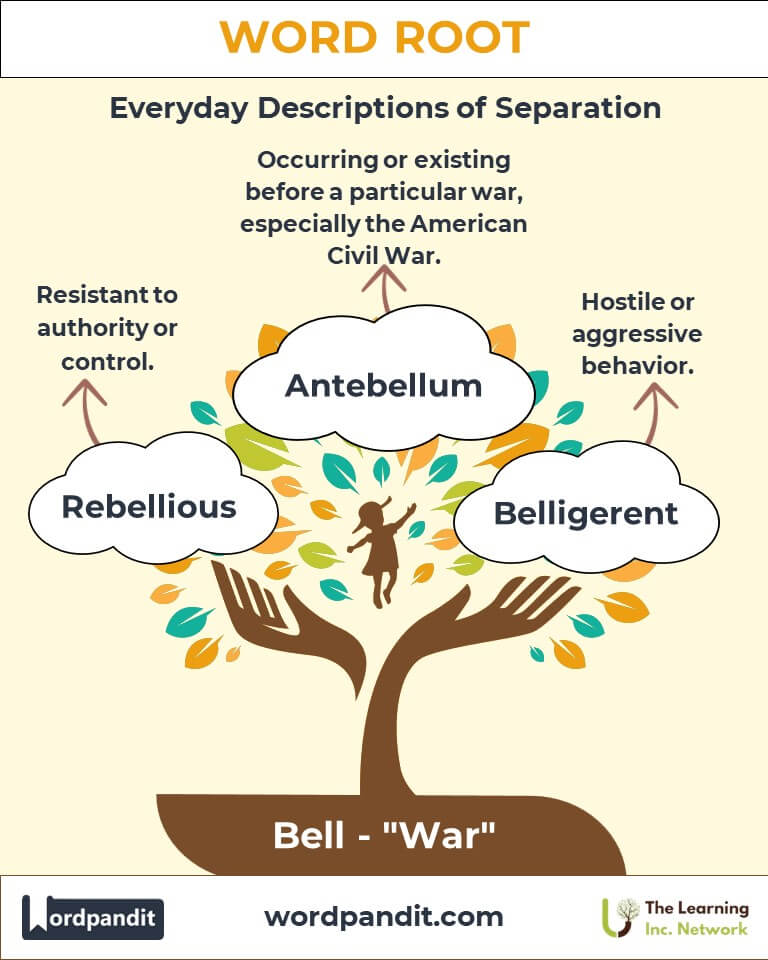Bell: The Resonance of Beauty and War Across Language and Culture
By exploring the word root Bell, we uncover its duality as a symbol of harmony and conflict. From its origins in Latin and Old English to its presence in modern science, literature, and technology, Bell has left a resounding mark on human expression. Whether describing the tolling of a bell or the strategy of war, this root bridges seemingly opposite concepts in fascinating ways.

Table of Contents
- Introduction: The Resonance of Bell
- Etymology and Historical Journey
- Mnemonic: Unlocking the Power of Bell
- Common Bell-Related Terms
- Bell Through Time
- Bell in Specialized Fields
- Illustrative Story: Bell in Action
- Cultural Significance of the Bell Root
- The Bell Family Tree
- FAQs About the Bell Root
- Test Your Knowledge: Bell Mastery Quiz
- Conclusion: The Lasting Legacy of Bell
1. Introduction: The Resonance of Bell
What connects the tranquil chime of a bell to the roar of a battlefield? The word root Bell encompasses both the beauty of harmonious sound (bellus, meaning beautiful in Latin) and the strife of war (bellum, Latin for war). Pronounced as "bel," this versatile root forms the backbone of words spanning peace, conflict, and aesthetic appreciation. From rebel to embellish, the legacy of Bell resonates across languages, highlighting the contrasts and connections within human experience.

2. Etymology and Historical Journey
The dual nature of Bell stems from two distinct Latin origins:
- Bellus: Meaning “beautiful” or “charming,” this root evolved into words celebrating elegance and refinement.
- Bellum: Signifying “war,” this root emerged from the Indo-European dweh₂- (to injure), symbolizing strife and contention.
In medieval Europe, the sound of bells marked both joyous celebrations and wartime alarms, embedding the root in the fabric of daily life. Over centuries, Bell expanded through French and Old English influences, finding its way into scientific, cultural, and everyday vocabularies.
3. Mnemonic: Unlocking the Power of Bell
Visual Mnemonic: Picture a bell that rings two distinct tones: one soft and melodious for peace (bellus), and another sharp and jarring for battle (bellum).
Phrase Mnemonic: "A beautiful melody can echo even in times of war," linking Bell’s dual themes of beauty and conflict.
4. Common Bell-Related Terms
- Belligerent: Inclined to or engaged in conflict.
Example: “The belligerent nations sought peace after years of war.” - Rebellion: An act of resistance against authority.
Example: “The rebellion was fueled by demands for justice and equality.” - Embellish: To beautify by adding details.
Example: “She embellished her story with vivid descriptions.” - Bellicose: Demonstrating aggression and a willingness to fight.
Example: “The leader’s bellicose rhetoric alarmed neighboring countries.” - Belle: A beautiful woman, especially one admired in social settings.
Example: “She was the belle of the ball, captivating everyone with her grace.”
5. Bell Through Time
- From Battlefields to Courtrooms:
Belligerent initially described warring factions in medieval Europe but later expanded to include legal disputes. - The Aesthetic Evolution of Embellish:
Once tied to physical decoration, embellish now encompasses storytelling, art, and digital design.
6. Bell in Specialized Fields
- History and Sociology: Terms like rebellion highlight societal struggles and the pursuit of freedom, reflecting historical revolutions and uprisings.
- Linguistics: Words derived from Bell reveal the interplay between conflict and beauty in human expression.
- Psychology: Bellicosity is studied as an aspect of personality, often linked to aggression and assertiveness.
- Technology: The Bell curve is a statistical tool crucial in fields like education and medicine, showcasing the root’s extension into analytical sciences.
- Art and Literature: The belle archetype persists in stories and films, often symbolizing grace and allure.
7. Illustrative Story: Bell in Action
In a bustling courtroom, renowned mediator Clara Bellman faced her toughest case yet—a feud between two communities over shared resources. Her deep understanding of belligerence helped her navigate the heated emotions, while her skill in embellishing compromise proposals inspired trust. By blending the conflict and charm inherent in Bell, Clara resolved the dispute, leaving both parties in harmony.
8. Cultural Significance of the Bell Root
From the church bells of medieval Europe to the Liberty Bell of America, the symbolism of bells spans cultures and eras. Bells represent both unity and alarm, echoing the dual meanings of Bell. Additionally, the aesthetic appreciation tied to bellus influenced Renaissance art and literature, celebrating beauty as a divine ideal.

9. The Bell Family Tree
- Pulchr (Latin pulcher): Meaning beautiful.
Examples: Pulchritude (physical beauty), pulchrous (beautiful). - Kalos (Greek kalos): Beautiful, noble.
Examples: Calligraphy (beautiful writing), kaleidoscope (beautiful forms). - Mar (Latin mars): Related to war.
Examples: Martial (warlike), martyr (one who suffers for a cause).
FAQs About the Bell Root
1. What does the root Bell mean?
The root Bell has two distinct meanings rooted in Latin: bellus, meaning "beautiful," and bellum, meaning "war." These divergent meanings give Bell its rich duality, spanning concepts of harmony and conflict.
2. Are Bellus and Bellum historically related?
Despite their similar appearance, these roots evolved independently in Latin. Bellus stems from a diminutive form implying beauty, while bellum is linked to Indo-European roots related to struggle and injury.
3. How does belligerent differ from bellicose?
While both relate to conflict, belligerent refers to entities actively engaged in a conflict (like nations at war), whereas bellicose describes a person or tone that is aggressive or warlike in demeanor.
4. Why is the Bell curve named so?
The Bell curve derives its name from its shape, which resembles the gentle curve of a bell. It is commonly used in statistics to represent normal distribution.
5. What is the origin of the term rebellion?
Rebellion combines the prefix re- (back or again) with bellum (war), implying a "return to conflict" or resistance against authority.
Test Your Knowledge: Bell Mastery Quiz
1. Which root does Belligerent stem from?
2. What does Embellish mean?
3. How are Belle and Bellicose related?
4. What does Rebellion imply?
5. Why is the Bell curve significant in statistics?
12. Conclusion: The Lasting Legacy of Bell
The Bell root embodies the paradox of human experience, connecting the sublime with the tumultuous. Its influence spans centuries, shaping fields as diverse as linguistics, mathematics, and cultural identity. As we continue to explore the nuances of language, Bell reminds us of the harmony and discord that define our world, urging us to find beauty even amid conflict.












